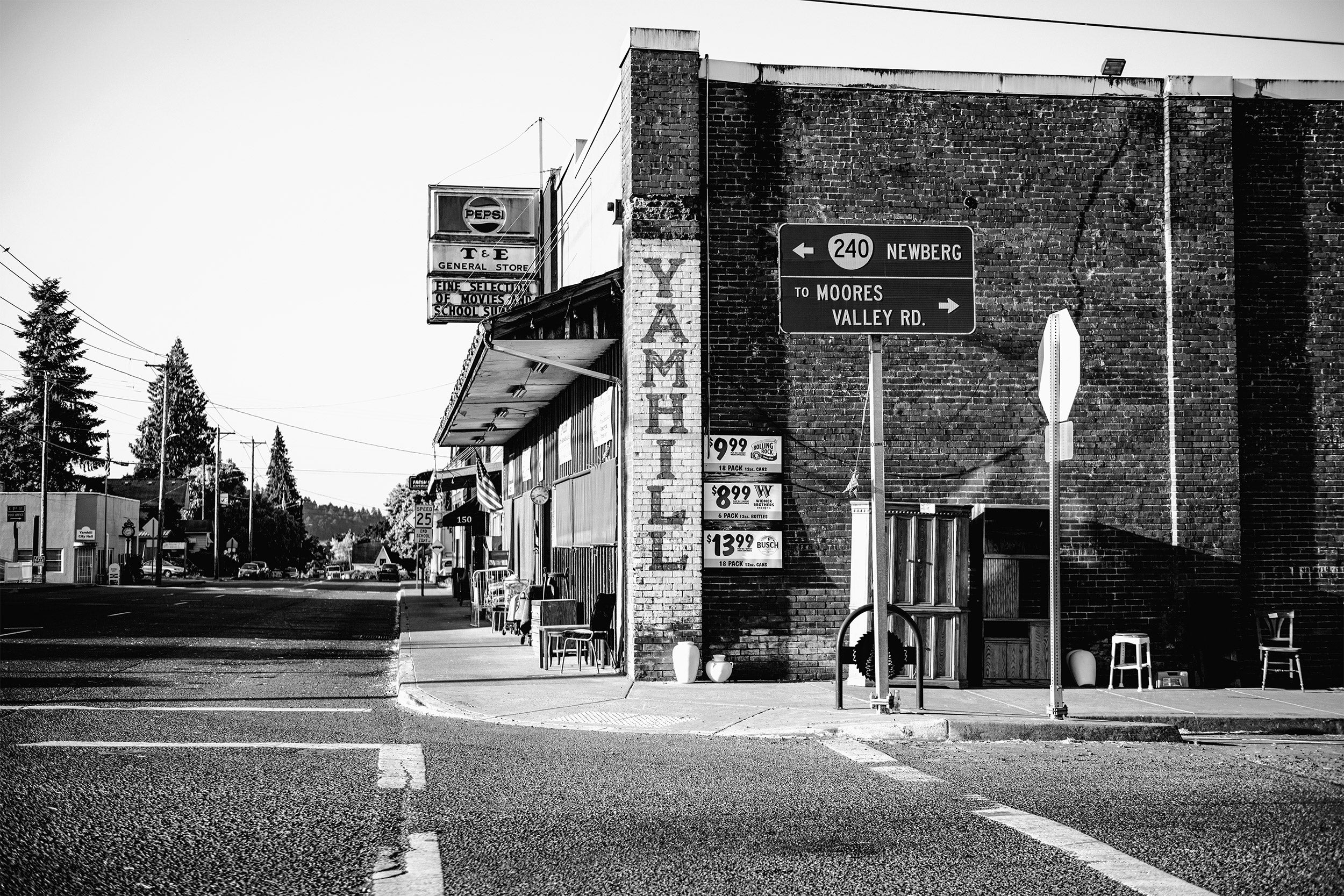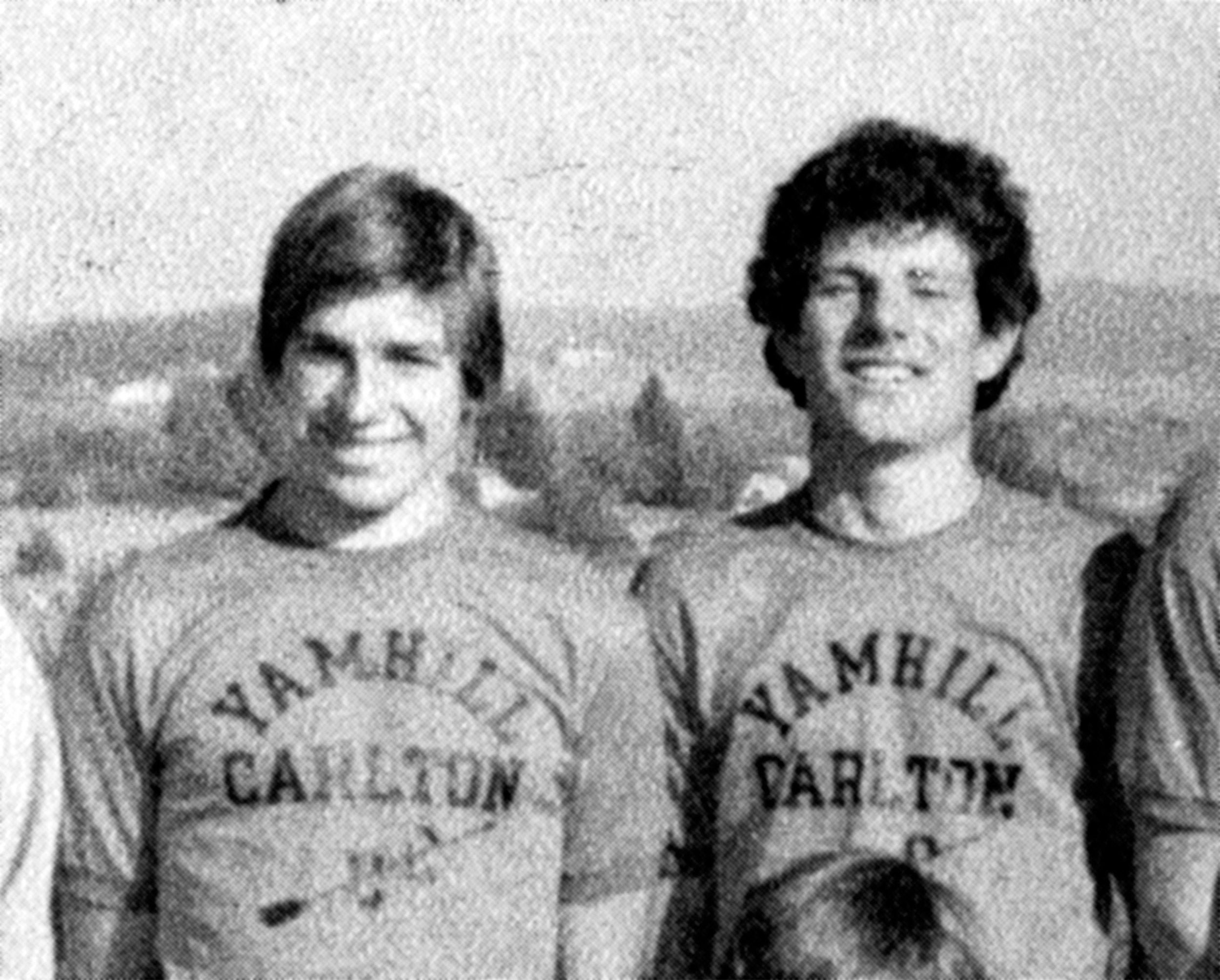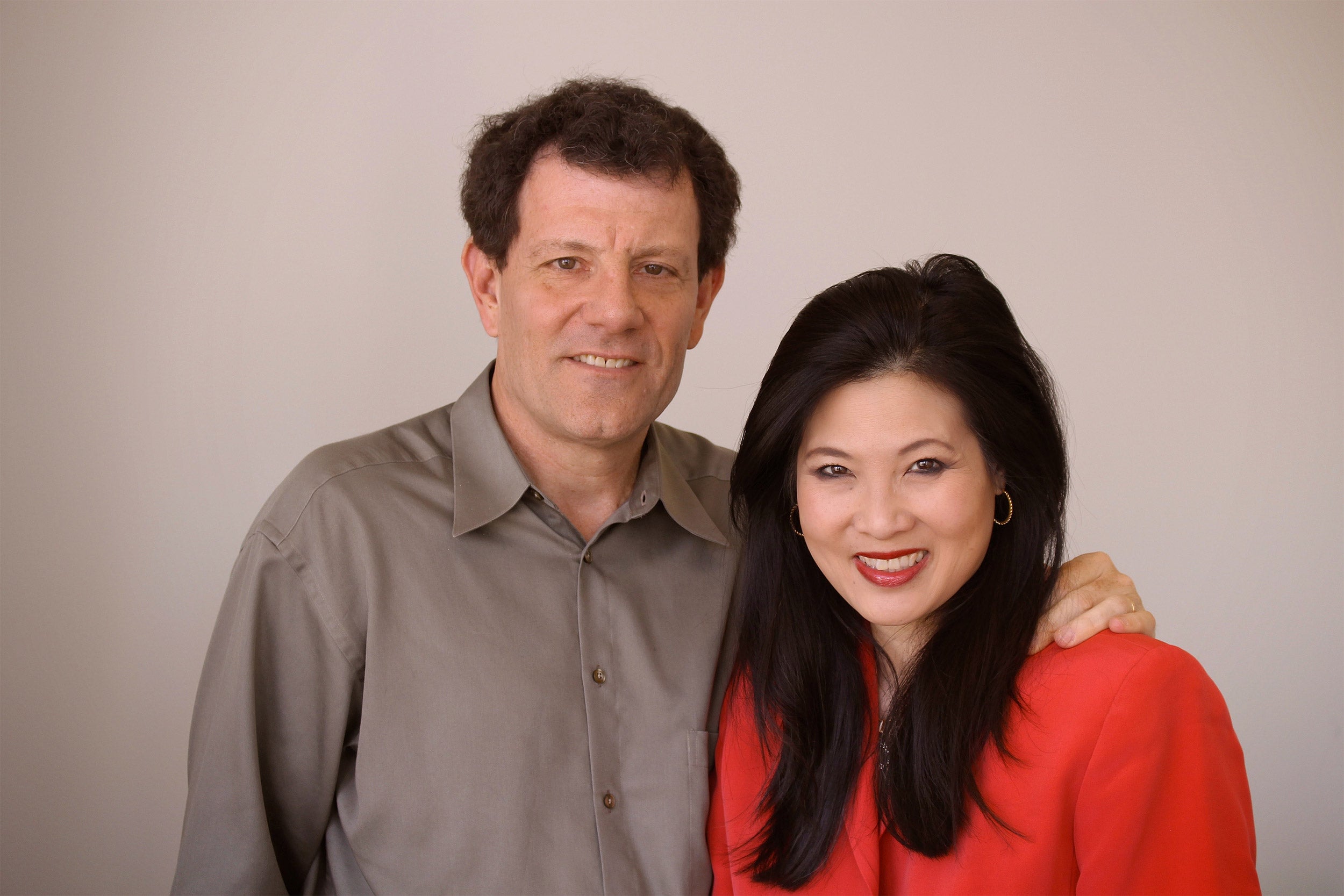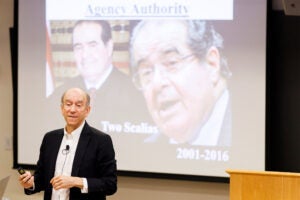
Yamhill general store. Photo by Lynsey Addario
How America went astray
In their new book, Nicholas Kristof and Sheryl WuDunn return to Kristof’s rural Oregon hometown to find the roots of white working-class anger
The following is excerpted from the new book “Tightrope: Americans Reaching for Hope” by Nicholas D. Kristof ’82 and Sheryl WuDunn MBA ’86. Kristof and WuDunn will be appearing on Jan. 27 at the Back Bay Events Center, 180 Berkeley St., Boston.
Kevin Green struggled economically for years. He died at home, age 54, in January 2015, after suffering from diabetes, urinary issues, and liver and heart problems. So much had changed since high school when he was a sleek cross-country runner with a shining future.
Shortly after mourning Kevin, our mutual friend Rick “Ricochet” Goff himself was dying after a lifetime of drink, drugs, and negligible health care. Ricochet was smart but had been expelled from school in eighth grade (as punishment for truancy!) and never recovered.
Mary Mayor, Nick’s seventh-grade crush, a sweet, raven-haired girl who was the daughter of the county trapper, also had gone off the rails. Mary was smart, hard working and resourceful: When her parents moved away after her junior year of high school, she wanted to graduate with her friends, so she got a job at the Yamhill Café, rented a room, and finished school on her own. But soon after graduation she was swamped by the wave of joblessness, despair, alcohol, and drugs sweeping the area. She spent seven years homeless, once putting a gun in her mouth to end it all. Her sister and three other relatives had already killed themselves. Just as she was about to squeeze the trigger, she thought of her daughter and paused; she decided to soldier on. Finally, with the help of a local church, Mary was able to start over. She is now sober and drug-free, making a living selling her own handcrafted birdhouses, though she still suffers pancreatitis from her drinking years.
Kevin, Ricochet, and Mary were good, capable, caring people who found themselves swamped by larger economic changes — and then that brokenness was passed to the next generation, with their children struggling with their own demons of addiction, unemployment, or incarceration. Yes, people made bad choices. In each case, the bad decisions were a symptom of larger economic malaise. In white America, the impact was focused on those who came of age in the late 1970s or afterward. Irene Green, Kevin’s widowed mom, had lost Thomas Jr., Cindy, and Kevin but was herself going strong physically and mentally at age 80. Her own mother had died recently at 97. The younger generations of Greens were far more troubled, and you could see the declining well-being of working-class America — and a visualization of America’s declining life expectancy — each time you looked around the Green dinner table. What we saw was a tragedy not just for one family, for the country cannot achieve its potential when so many citizens are not reaching theirs.

Mary Mayor, after a great recovery from alcohol, drugs , and homelessness, with one of the birdhouses she makes and sells for a living.
Photo by Nicolas D. Kristof
This is not an exclusively liberal or conservative issue. Conservative writers like Charles Murray and David Brooks have explored these chasms, with Brooks arguing that “the central problem of our time is the stagnation of middle-class wages, the disintegration of working-class communities and the ensuing fragmentation of American society.” On the left, Senator Elizabeth Warren and many other Democrats have made similar arguments. Remarkably, this pain in white working-class America helped account for the rise of both Donald Trump on the right and Bernie Sanders on the left.
What went wrong?
For much of the 19th and 20th centuries, the United States had pioneered efforts to create opportunity. The Homestead Acts, beginning in 1862, were a self-help program that gave American families 160 acres of land each if they farmed it productively or improved it over five years. Homesteads transformed the West, and one-quarter of Americans can trace some of their family wealth to that visionary initiative. Another historic program was rural electrification, which beginning in 1936 brought electricity (and later telephone service) to farmers across America, transforming rural life, improving productivity and multiplying opportunity.
The United States was one of the first countries nations to offer near universal basic education, and then one of the first to introduce high schools for nearly all children. “By the early 20th century America educated its youth to a far greater extent than did most, if not every, European country,” Claudia Goldin and Lawrence F. Katz write in “The Race Between Education and Technology,” their exploration of how investments in human capital made America the world’s leading country. A state university and community college system made tertiary education widespread, and the GI Bill of Rights vastly expanded educational attainment and homeownership in America.
There were many other historic initiatives in the early 20th century that put the United States on a progressive path. In the 1930s, Congress approved social safety net programs like Social Security, unemployment insurance and jobs initiatives like the Civilian Conservation Corps. Other countries later adopted many elements of these programs.
Then in about 1970, America went off track, beginning a nearly half-century drift in the wrong direction. High-school graduation rates tumbled from the highest to among the lowest in the industrialized world. Incarceration rose sevenfold. Family structure collapsed. Single-parent households soared. Life expectancy peaked. Working-class incomes grew glacially, if at all. And today the top 1 percent owns twice as great a share of national wealth as the entire bottom 90 percent. We went from being a world leader in opportunity to being a laggard.
The decline in education leadership is particularly significant, because good jobs increasingly require a solid educational foundation. Globalization, automation, and a relentless focus on cost cutting led to a hollowing out of urban blue-collar and clerical jobs that in the past were often performed by people with limited education. David Autor, an economist at MIT, has found that as a result, urban workers with only a high-school education fill jobs that are actually lower skilled now than back in the 1970s.


Young Nicholas Kristof and his friend Kevin Green. Green in 1983 with a four-and-a-half pound trout he had caught. An enthusiastic fisherman, Green once dove into a river and caught a fish with his hands.
Courtesy of Yamhill-Carlton High School; courtesy of Irene Green
One reason Kevin Green floundered was that he hadn’t graduated from high school. That hadn’t been an impediment for earlier generations of blue-collar workers, including his dad, for in the early 1970s some 72 percent of American jobs required only a high-school education or less. By 2020, that will have fallen to 36 percent. One consequence is a plunge in earnings for those with limited education. In the 1970s, a male high-school graduate earned on average almost four-fifths as much as a male college graduate, but that has fallen to just over 50 percent. And those like Kevin who didn’t graduate from high school do even worse.
In 1970, tax revenue made up about the same share of gross national product in the United States as the average in the OECD, the club of industrialized nations. It then inched up in every other rich country, as one might expect when populations age and need more public services, while remaining unchanged in the United States. So people in other wealthy countries today pay about an extra 10 cents on the dollar in taxes, but in exchange get health insurance, better infrastructure, less poverty, reduced homelessness and, we’d argue, a healthier society.
One sign that the United States was moving rightward and following a different trajectory than the rest of the West was the election of Ronald Reagan in 1980. Reagan both reflected and shaped the country’s mood in the 1970s when in his speeches he regularly denounced a Chicago welfare recipient: “She has eighty names, thirty addresses, twelve Social Security cards and is collecting veteran’s benefits on four nonexistent deceased husbands.” After his election to the presidency, he famously declared in his inaugural address in 1981, “Government is not the solution to our problem; government is the problem.” He broke the air traffic controllers’ union; worker protections declined; and the business world became much more powerful.
As hostility toward government spread in America, there have been determined efforts to cut taxes, particularly for the wealthy, and then “starve the beast” — using reduced revenue to justify cuts in services for the disadvantaged. This is both disingenuous and cruel, as well as out of step with the advanced world. Other countries over the decades expanded health-care coverage, adopted family-leave policies, extended mass transit and implemented child allowances to reduce poverty, while the United States bucked the trend by slashing taxes, cutting back hours at public libraries, raising tuition at state universities, and allowing infrastructure to decay. Grover Norquist, an influential Republican advocate for lower tax rates, captured the small government ideology: “My goal is to cut government in half in 25 years, to get it down to the size where we can drown it in the bathtub.”
Why did the United States drift so far rightward in a way other countries mostly did not? We wonder if one reason wasn’t national anxiety about race, violence, and unrest beginning in the mid-1960s. This was the time of assassinations of John F. Kennedy, Robert Kennedy, and Martin Luther King Jr., of political riots in Chicago, of race riots in Los Angeles, Newark, Detroit, and other cities, of domestic terrorists like the Weathermen, of talk of revolution, of hippies and yuppies, of furious debates in households across America. Repeated psychology experiments have shown that fear makes us more conservative in our political beliefs, and Richard Nixon seized upon the fears in 1968 when he ran for president with coded dog whistles playing on white apprehensions of black unrest.
This “southern strategy” turned the South into a GOP bastion, and the fearmongering has often extended into social policies as well. Welfare was portrayed as handouts to lazy blacks, and immigration as a threat to American culture and jobs. The lack of social-support policies then led to a certain despair and disintegration of traditional communities, amplifying fears that traditional values were being lost and pushing states that once had progressive streaks, like Iowa and Oklahoma, firmly into the Republican camp.
Another factor was the inflation of the 1970s and the recognition that American business had grown too complacent, so that the economy really did need a kick in the pants. European and Japanese corporations were gaining ground, and some union rules did suppress innovation and labor-saving efficiencies. There were legitimate grounds for deregulation and also a genuine need for new industries like venture capital and private equity that forced efficiencies in the bloated private sector. But we then went too far in unleashing unfettered capitalism. As the business writer Steven Pearlstein put it: “What began as a useful corrective has, 25 years later, become a morally corrupting and self-defeating economic dogma that threatens the future of American capitalism. Our current prosperity is not sustainable because it is not producing the kind of society that most of us desire.”
In 1965, the average chief executive earned about 20 times as much as the average worker; now the average CEO earns more than 300 times as much. A Walmart employee earning the median salary at the company, $19,177, would have to work for 1,188 years to earn as much as the chief executive did in 2018 alone. Companies also changed the ways they operated, outsourcing custodial jobs and eliminating pensions in ways that raised share prices but left many families more vulnerable.
Arkansas in 2018 became the first state to impose work requirements for Medicaid. It also required participants to log their work hours online with an email address and a code sent by mail. Unfortunately, Arkansas ranks 48th among states in internet access …
Oren Cass, a former management consultant at Bain & Company who was domestic policy director for Mitt Romney’s presidential campaign, understands the arguments for business efficiencies. He notes that the erosion of the old labor market resulted in strong overall economic growth and cheap products. But the trade-off was not worth it, he adds. In his book “The Once and Future Worker,” he cautions, “What we have been left with is a society teetering atop eroded foundations, lacking structural integrity, and heading toward collapse.”
Whereas government historically had helped struggling Americans with measures like the GI Bill of Rights, it retreated just as disappearing jobs, proliferating drug use and disintegrating families increased the need for social services. The churches, schools, and community organizations could not respond adequately when faced with these dark new forces, so government officials instinctively lashed back with mass incarceration that only compounded the problems.
It’s puzzling that many politicians fear that poor people are trying to milk the system, while they don’t seem to fear rich people doing the same with far more dollars at stake. The latest fashion for smacking the downtrodden among some lawmakers: work requirements to receive benefits such as Medicaid. Arkansas in 2018 became the first state to impose work requirements for Medicaid. It also required participants to log their work hours online with an email address and a code sent by mail. Unfortunately, Arkansas ranks 48th among states in internet access, and many Medicaid recipients have no email or internet. Of the first group subjected to the requirement, 72 percent could not comply. So families lost health insurance, and then some people were unable to get medication and, their sicknesses flaring, lost jobs. Meanwhile, from 2007 to 2016, the state granted subsidies of $156 million to corporations, including HP and Caterpillar, under an “economic development” program that researchers found had almost no correlation to increased employment.
In the past half century America has failed particularly in creating inclusive growth. Poor parts of the country had been catching up with the rich parts for much of the 20th century. Mississippi went from 30 percent of the per capita income in Massachusetts in the 1930s to almost 70 percent by 1975, and similar trends were apparent in other southern states. But that trend slowed and then reversed, so that Mississippi is now down to 55 percent of the Massachusetts per capita income. The reasons seem to be in part self-inflicted. There has been a growing premium in the labor market for educated workers, but Mississippi and other southern states have underinvested in education. The South’s strategy was to cut taxes, believing low taxes would attract businesses and boost growth, but this was not terribly effective in the age of the knowledge economy. High-paying, high-technology companies require a pool of educated workers, so they often end up investing in high-tax, high-education states like California, Massachusetts, and New York. This is amplified when right-wing politicians in the South defend Confederate statues or demonize gays or transgender people, and the result is further economic backwardness and frustration. And the cycle repeats.
Not since the Great Depression has America experienced the kind of working-class stagnation that we’ve seen in recent decades, and it has fed polarization, racism, and bigotry, gnawing away at our social fabric.
Not since the Great Depression has America experienced the kind of working-class stagnation that we’ve seen in recent decades, and it has fed polarization, racism, and bigotry, gnawing away at our social fabric. Resentment has grown toward Latinos, Muslims, and African Americans. White supremacists gained ground, and on websites and social media Americans glibly trumpet their bigotry. Hate crimes have increased in the United States for three years in a row, the FBI reported. On one ultra-right website we visited, people posted venomous statements about Muslims and called for mass deportation. One woman proposed, “Any Muslim man wanting to come into our country must be castrated first.”
Is this America?
The white working class has genuine grievances. It has greatly suffered from rising inequality, from a minimum wage falling in real terms and from inattention by Washington politicians. Perhaps as a result, this demographic is also extremely distrustful of politicians and political solutions — 93 percent say they have an unfavorable view of politicians.
“This creates a dilemma for Democrats,” the economist Isabel Sawhill notes in her book “The Forgotten Americans.” “Any activist agenda risks driving even more of the working class into the Republican camp, especially if that agenda relies on Washington-led policy making and new taxes.” So far, these voters have doubled down on politicians who want to move the United States farther away from the trend in the Western world.
President Donald Trump’s election in 2016 was a manifestation of that trend. Trump did extremely well in areas with high death rates for whites aged 40 to 64. Many of these working-class voters had supported Presidents Obama and Clinton but now switched sides and backed Trump. “People felt ignored,” Republican pollster Frank Luntz told us. “And Donald Trump spoke to them.” Once in office, of course, Trump chipped away at the Affordable Care Act, so that fewer Americans were insured than would otherwise have been the case. Less insurance in turn means more die from heart disease, cervical cancer, and liver ailments, and fewer have access to addiction treatment, a tragic wrong for his working-class supporters.
In Oklahoma, we met a kindergarten teacher named Rhonda McCracken who fervently supports the local domestic violence intervention center, which she said helped her escape a brutal ex-husband who beat and choked her. Staff at the domestic violence center helped McCracken escape that relationship and start over.
“They saved my life, and my son’s,” she told us, her eyes liquid.
So how does McCracken vote? “I voted for President Trump,” she told us, noting that she is a Republican, and it seemed natural to support him. Soon after taking office, Trump attempted to cut funds that finance the domestic violence center, and McCracken was aghast. “My prayer is that Congress will step in” to protect domestic violence programs, she told us. Yet she did not regret her vote for Trump, and she was generally sympathetic with his desire to cut spending. She said she might support his reelection.
Because many readers are likely to find the support for the GOP unfathomable in places that are hurting so badly, we asked our Yamhill friend and neighbor Dave Peper to explain his politics. Dave has endured tough times — including seven episodes of homelessness — but is a firm supporter of Trump. One reason is that he’s a believer in gun rights and carries a loaded handgun on his hip at all times. But Dave says that he’s also fed up with paying taxes to support social programs that, as he sees it, go to support deadbeats who don’t want to work.
“I think we need welfare reform like you can’t believe,” he said. “I believe there’s a ton of people out there milking this system to death. I’m sick and tired of paying for it. I really am. My taxes tend to go up, but my road never gets fixed.” As examples of people milking the system, he cites people in the area who don’t seem much interested in working hard but get food stamps or disability.
For all his strong support for Trump, Dave acknowledged being troubled by the polarization and nastiness of politics today. “I don’t know what the solution is,” he added, “but I just pray every night for my country and my home.” Dave reflected local sentiments. In Yamhill in 2016, Trump captured 57 percent of the vote, and Hillary Clinton 32 percent (most of the rest went to Gary Johnson, the libertarian candidate). As went Yamhill, so went much of white, working-class America.

“Tightrope” authors Nicholas D. Kristof and Sheryl WuDunn are the first husband and wife to share a Pulitzer Prize for journalism.
Picasa
Working-class voters are not uniformly conservative in their views. Polls show that they favor higher taxes on the rich, paid family leave, and a higher minimum wage. But the working poor are disdainful of government benefits, even though they sometimes rely on them, partly because they often see firsthand how neighbors abuse those benefits; there’s far more anger at perceived welfare abuses than at larger subsidies for private jets. The resentment is more visceral when it is people around them who are bending rules and benefiting unfairly.
Rev. Rhonda Kroeker in Yamhill shares some of that concern, and she, too, is sympathetic to Trump. “People just want a more simple life,” she told us. “They want America to be great again. The way it was when we were kids.” Pressed on what that simple life would look like, she thought for a moment and answered, “Just the America we grew up in. I was proud to be an American girl. Families were important. It was important to go to school. It was important to have a job. Try and do the right thing for your family. I don’t know. Maybe they see that in Trump.”
We believe that nostalgia is widespread. We also argue that this supposed golden era had a dark side: In the early 1960s, before the wave of changes in America, women had few opportunities; African Americans lived under Jim Crow laws; and family planning was banned in most states for unmarried women. As recently as 1987, only half of Americans said that it was always wrong for a man to beat his wife with a belt or stick. A 1963 poll found that 59 percent of Americans believed that black-white marriages should be illegal, and interracial marriage was still banned in 16 states as recently as 1967, when the Supreme Court overturned such laws in the case of Loving v. Virginia.
Yet it’s true that there were indeed elements of that era that were important and that have been lost. Inequality was lower, and working-class families enjoyed huge gains in education, incomes, standard of living. Families had their problems, but children were far more likely to be raised in intact, robust two-parent households, and there was very little homelessness. One simple gauge of well-being: suicide rates were much lower than today. Few of our friends understood the plight of those struggling more viscerally than Mary Mayor, Nick’s old friend who had spent years homeless and once put a gun in her mouth. So we asked Mary if she supported politicians who would take a different course to fix America. Yes, she said, although she acknowledged that she wasn’t terribly interested in politics and had never actually voted until 2016. “It was just too complex,” she told us. “And I got confused with this or that.” But finally, she said, she voted for change because the stakes were so high. Casting a ballot for the first time in her life, she voted for Donald Trump.
“Trump is our only hope,” Mary told us. “The man’s dirty, you know? But he’s still plugging forward.” She said she wished that Trump would get off Twitter, but added that the economy was doing better, with more jobs available. The media are unfair to Trump, she said, while giving Democrats a pass.
In the middle of a series of Trump scandals, we asked Mary how she thought Trump was doing so far. She paused thoughtfully and said firmly, “He’s done a good job.”
“He believes in the American people,” she added. “I feel great to call myself an American once again.”
Copyright 2019 by Nicholas D. Kristof and Sheryl WuDunn. Excerpted by permission of Alfred A. Knopf, a division of Penguin Random House LLC. All rights reserved. No part of this excerpt may be reproduced or reprinted without permission in writing from the publisher.




